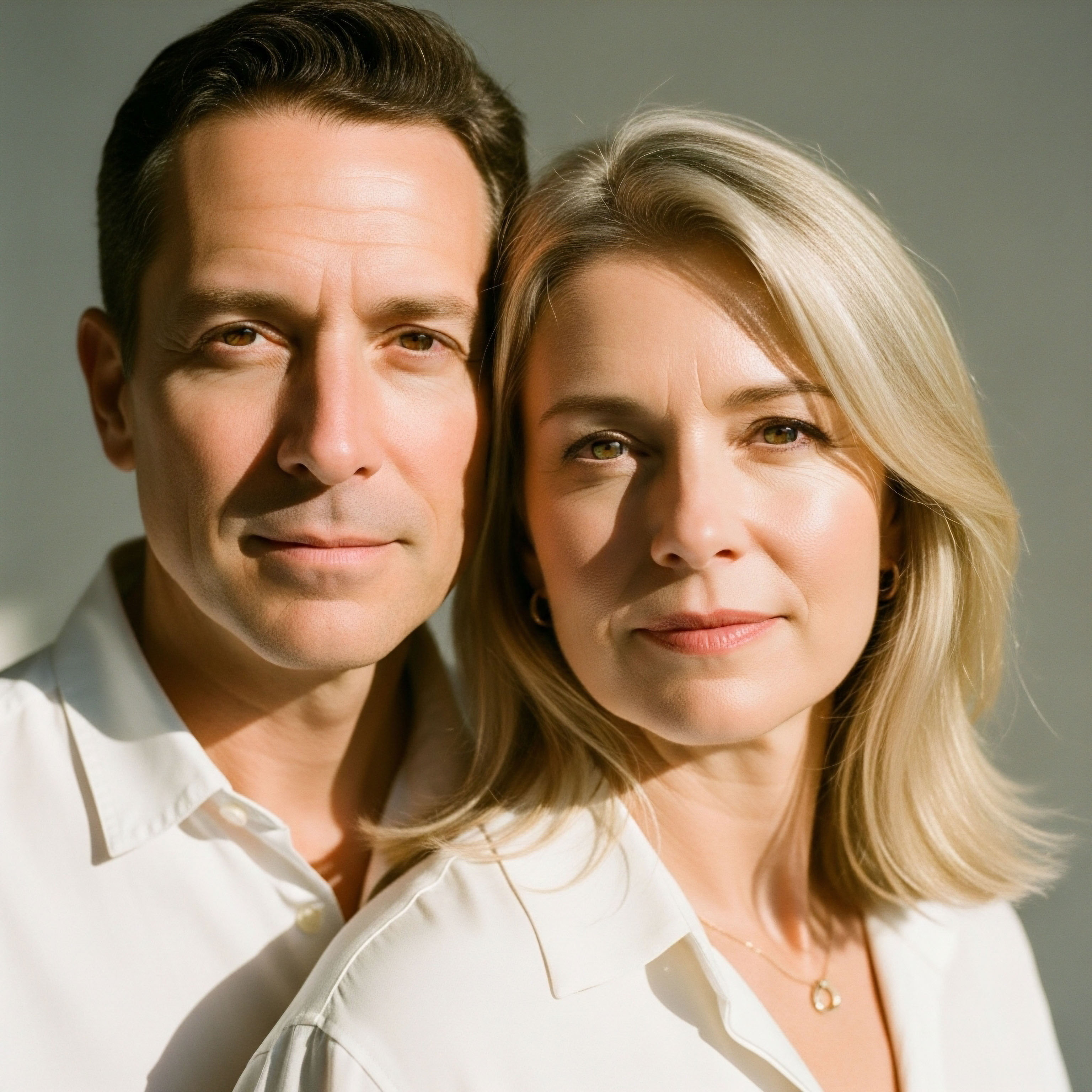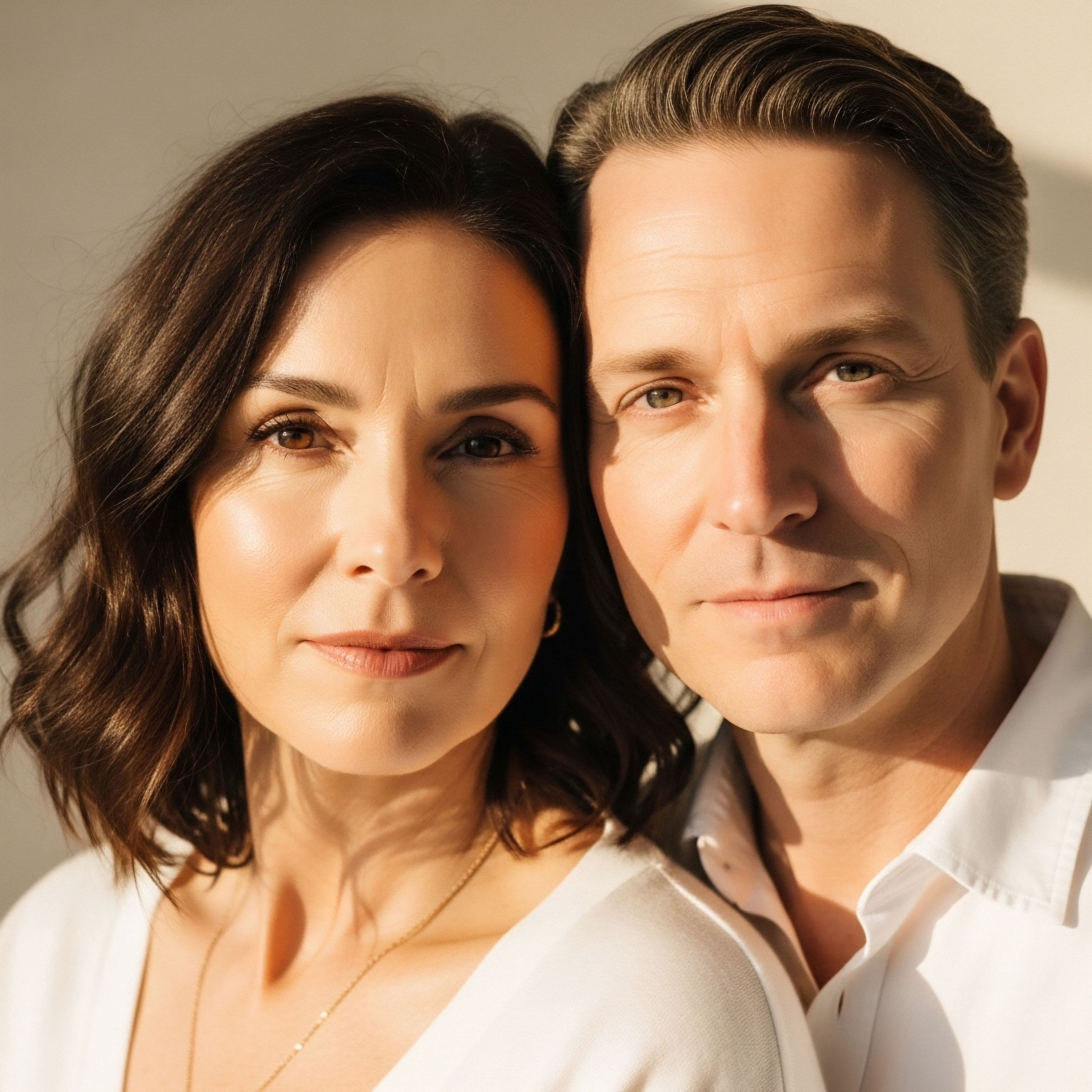

Fundamentals
The decision to begin a journey of hormonal optimization often starts not with a clear diagnosis, but with a collection of subtle feelings. It could be a persistent lack of energy that coffee no longer fixes, a mental fog that clouds focus, or a gradual decline in physical strength and desire that feels premature.
These experiences are valid and deeply personal. They represent a shift in your body’s internal communication system, a complex and elegant network where hormones act as messengers, carrying vital instructions to every cell. Understanding this system is the first step toward reclaiming your sense of self.
At the center of male hormonal health is testosterone. Its role extends far beyond muscle mass and libido; it is a foundational element for cognitive function, mood regulation, bone density, and metabolic efficiency. When its levels decline, the effects ripple outward, touching nearly every aspect of well-being.
Testosterone replacement therapy (TRT) is a protocol designed to restore this crucial messenger to its optimal operational levels. The process involves carefully reintroducing testosterone into the body to re-establish its essential functions.

The Endocrine System a Delicate Balance
Your endocrine system functions like a finely tuned orchestra, with each hormone playing a specific instrument. Testosterone is a lead violin, but its performance is intrinsically linked to the entire ensemble. The Hypothalamic-Pituitary-Gonadal (HPG) axis is the conductor of this section, a sophisticated feedback loop that monitors and adjusts testosterone production.
The hypothalamus signals the pituitary gland, which in turn signals the testes to produce testosterone. When external testosterone is introduced, this internal production line slows down or stops. This is a normal and expected physiological response. The challenge arises when this recalibration is not properly managed or when other factors interfere with the new hormonal environment.
Unrecognized interactions in this context are not limited to prescription medications. They encompass a wide array of inputs that can disrupt the delicate hormonal symphony you are trying to restore. These can include:
- Nutritional Deficiencies ∞ Zinc, magnesium, and Vitamin D are critical cofactors in testosterone synthesis and receptor sensitivity. An inadequate supply can blunt the effectiveness of therapy.
- Chronic Stress ∞ Persistent stress elevates cortisol, a hormone that has an antagonistic relationship with testosterone. High cortisol levels can suppress testosterone’s beneficial effects, even when levels are supplemented.
- Poor Sleep Quality ∞ The majority of natural testosterone production occurs during deep sleep. Chronic sleep deprivation disrupts this rhythm and can interfere with the body’s ability to properly utilize supplemented testosterone.
- Over-the-Counter Supplements ∞ Certain herbal supplements can influence liver enzymes or hormone-binding proteins, altering how testosterone is metabolized and how much of it is freely available to your cells.

What Are the Initial Signs of an Interaction?
When you begin a hormonal optimization protocol, you are establishing a new baseline. The initial period is one of adjustment, but certain signs may indicate an unrecognized interaction is occurring. You might notice a return of the very symptoms you sought to alleviate, such as fatigue or low mood.
Alternatively, new issues may appear, like skin breakouts, mood swings, or fluid retention. These are not necessarily signs that the therapy is failing. Instead, they are signals from your body that the balance is not yet right, that some other factor is influencing the outcome. Acknowledging these signals without alarm, and communicating them to a clinical professional, is a critical part of a successful and sustainable health journey.
Your body’s symptoms are a form of communication, providing essential feedback on your journey to hormonal balance.
The goal of a well-managed protocol is to create a stable physiological environment where supplemented testosterone can perform its functions without being undermined by competing signals. This requires a holistic view of your health, where TRT is one component of a comprehensive strategy.
The long-term consequences of failing to recognize and address these interactions stem from allowing this state of imbalance to persist, leading to a cascade of systemic issues that can undermine the very foundation of your health.


Intermediate
Moving beyond the foundational understanding of hormonal balance, we arrive at the clinical mechanics of a properly structured Testosterone Replacement Therapy (TRT) protocol. The objective is a precise recalibration of the endocrine system. This process uses specific therapeutic agents to not only restore testosterone levels but also to manage the physiological consequences of that restoration.
An unrecognized interaction at this stage can derail the entire process, leading to suboptimal results and potentially creating new health challenges. The long-term effects are a direct result of a sustained, uncorrected imbalance in this carefully managed system.

Core Components of a Modern TRT Protocol
A comprehensive TRT protocol for men is designed as a multi-faceted system. It acknowledges that simply adding testosterone is insufficient. The body’s response to this external input must be anticipated and guided. A typical, clinically-informed protocol includes several key components:
- Testosterone Cypionate ∞ This is a bioidentical, injectable form of testosterone that provides a stable, long-lasting elevation of serum testosterone levels. Weekly intramuscular or subcutaneous injections are standard, allowing for consistent physiological concentrations and minimizing peaks and troughs.
- Anastrozole ∞ When testosterone is introduced, a portion of it is naturally converted into estrogen by an enzyme called aromatase. While some estrogen is vital for male health (supporting bone density and cognitive function), excessive conversion can lead to side effects like gynecomastia (breast tissue development), water retention, and moodiness. Anastrozole is an aromatase inhibitor, a medication that blocks this conversion process, helping to maintain an optimal testosterone-to-estrogen ratio.
- Gonadorelin or hCG ∞ Introducing external testosterone signals the HPG axis to shut down natural production, which can lead to testicular atrophy and reduced fertility. Gonadorelin, a synthetic form of Gonadotropin-Releasing Hormone (GnRH), or Human Chorionic Gonadotropin (hCG), which mimics Luteinizing Hormone (LH), is used to directly stimulate the testes. This maintains their size and function, preserving a degree of natural hormonal activity and fertility.
- Enclomiphene ∞ In some protocols, Enclomiphene may be used. It is a selective estrogen receptor modulator (SERM) that can help stimulate the pituitary to produce more LH and Follicle-Stimulating Hormone (FSH), further supporting natural testicular function and sperm production.

How Do Unrecognized Drug Interactions Disrupt the System?
The intricate balance of a TRT protocol can be significantly disrupted by interactions with other common medications. These interactions are often overlooked because they are not immediately obvious. They can subtly alter the pharmacokinetics (what the body does to the drug) or pharmacodynamics (what the drug does to thebody) of the therapeutic agents.
A successful TRT protocol functions as a managed ecosystem, where unrecognized external chemicals can act as invasive species, disrupting the intended balance.
Consider the following common scenarios where interactions can lead to long-term negative consequences:

Table of Common Pharmaceutical Interactions with TRT
| Interacting Drug Class | Mechanism of Interaction | Potential Long-Term Consequence |
|---|---|---|
| Statins (e.g. Atorvastatin) | Some statins can lower Sex Hormone-Binding Globulin (SHBG), the protein that carries testosterone in the blood. This increases the amount of “free” testosterone, potentially leading to higher-than-intended levels and increased aromatization into estrogen. | Chronically elevated estrogen levels, increased risk of cardiovascular strain due to fluid retention, and potential for gynecomastia. The Anastrozole dosage may become insufficient. |
| Antidepressants (SSRIs) | SSRIs can impact libido and sexual function through complex neurological pathways. They can also influence the perception of well-being, masking the true effects of the TRT protocol or creating confounding symptoms. | Persistent sexual dysfunction despite optimized testosterone levels, leading to frustration and protocol abandonment. Difficulty in assessing the true efficacy of the hormonal therapy. |
| Blood Pressure Medications (e.g. Beta-Blockers) | Some beta-blockers can cause fatigue and erectile dysfunction, symptoms that directly overlap with those of low testosterone. This can make it difficult to titrate the TRT dose correctly. | Unnecessary dose escalations of testosterone in an attempt to treat a medication side effect, leading to supraphysiological levels and associated risks like polycythemia (high red blood cell count). |
| Opioid Analgesics | Chronic opioid use is a well-documented cause of secondary hypogonadism by suppressing the HPG axis. This creates a powerful counter-signal to the TRT protocol. | A constant struggle to achieve therapeutic goals, requiring higher doses of testosterone and ancillary medications, increasing the overall risk profile and metabolic burden on the body. |
These examples illustrate that the consequences are not isolated events. They are systemic. An unrecognized interaction with a statin doesn’t just affect estrogen; it creates a cascade that can impact cardiovascular health. An interaction with a blood pressure medication can lead to a dangerous thickening of the blood. The long-term health consequences are the cumulative result of these uncorrected systemic dysfunctions.


Academic
An academic exploration of the long-term consequences of unrecognized TRT interactions requires a shift in perspective from systemic overview to molecular detail. The most profound and often overlooked interactions occur at the intersection of hormonal signaling and metabolic regulation.
Specifically, the interplay between exogenous androgens, insulin sensitivity, and hepatic lipid metabolism represents a critical nexus where unrecognized factors can precipitate significant, long-term pathology. The failure to account for these interactions moves beyond symptomatic inconvenience and becomes a matter of cardiometabolic risk potentiation.

The Hepatic Axis Testosterone, SHBG, and Lipid Dysregulation
The liver is the central processing hub for both steroid hormones and lipids. Testosterone administration directly influences hepatic function. One of its primary effects is the suppression of Sex Hormone-Binding Globulin (SHBG) synthesis. While this is often viewed as beneficial for increasing free testosterone, it is a marker of a deeper metabolic shift.
SHBG is not merely a passive carrier protein; it is an independent predictor of metabolic syndrome and type 2 diabetes risk. Low SHBG is strongly correlated with insulin resistance.
An unrecognized interaction, for instance with a medication that also independently lowers SHBG or induces hepatic steatosis (fatty liver), can create a synergistic effect. This accelerates the progression toward a state of profound insulin resistance. In this state, the body’s cells become less responsive to insulin, requiring the pancreas to produce more of it to manage blood glucose.
This resulting hyperinsulinemia is a key driver of systemic inflammation, endothelial dysfunction (damage to the lining of blood vessels), and the development of atherosclerotic plaques. The TRT protocol, intended to be restorative, can inadvertently contribute to this pathological process if the full metabolic context is not appreciated.

Polycythemia and Cardiovascular Risk a Hematological Perspective
One of the most well-documented effects of testosterone therapy is the stimulation of erythropoiesis, the production of red blood cells, which can lead to erythrocytosis or polycythemia (a hematocrit level >50-54%). Testosterone promotes the production of erythropoietin (EPO) in the kidneys and directly stimulates bone marrow. While a modest increase in red blood cell mass can improve oxygen-carrying capacity, excessive levels significantly increase blood viscosity.
This thickening of the blood elevates the risk of thromboembolic events, such as deep vein thrombosis, pulmonary embolism, myocardial infarction, and stroke. An unrecognized interaction here could involve concurrent use of substances that also promote red blood cell production or, more subtly, a state of chronic dehydration or sleep apnea.
Obstructive sleep apnea, which can be exacerbated by TRT, causes intermittent hypoxia (low oxygen levels). This hypoxia is a powerful stimulus for EPO production, creating a dangerous feedback loop where TRT worsens sleep apnea, and the resulting hypoxia further drives polycythemia. Without screening for and addressing the sleep apnea, the clinician may be unaware of the true driver behind the rising hematocrit, misattributing it solely to the testosterone dose.
The long-term risk of TRT is not from testosterone itself, but from its potentiation of underlying, unaddressed pathologies.

Table of Mechanistic Pathways and Long-Term Outcomes
| Biological Pathway | Effect of TRT | Unrecognized Interacting Factor | Long-Term Pathological Consequence |
|---|---|---|---|
| Aromatase Activity | Provides substrate (testosterone) for conversion to estradiol. | High visceral adiposity (obesity), which is a major site of extragonadal aromatase activity. Alcohol consumption, which can also increase aromatization. | Supraphysiological estradiol levels, leading to chronic inflammation, gynecomastia, and increased risk of venous thromboembolism. The standard dose of an aromatase inhibitor may be insufficient. |
| Prostate Tissue Homeostasis | Provides androgenic stimulation to prostate cells. | A pre-existing, undiagnosed low-grade prostate malignancy. The “Saturation Model” suggests that prostate androgen receptors are saturated at relatively low testosterone levels, but this may not hold true for all prostatic tissue, especially neoplastic cells. | Acceleration of prostate cancer growth. While TRT is not considered to cause prostate cancer, it can promote the growth of an existing tumor. This underscores the criticality of thorough screening before and during therapy. |
| Renin-Angiotensin-Aldosterone System (RAAS) | Testosterone can influence this system, leading to sodium and water retention. | High sodium diet; concurrent use of NSAIDs which can also cause fluid retention; underlying renal insufficiency. | Sustained hypertension, increased cardiac preload, and exacerbation of heart failure in susceptible individuals. |

What Is the True Nature of Cardiovascular Risk?
The debate over TRT and cardiovascular disease has been contentious, with studies showing conflicting results. A mechanistic understanding suggests the risk is not from testosterone itself, but from the failure to manage its metabolic and hematological effects.
A patient on TRT with unrecognized and uncontrolled erythrocytosis, dyslipidemia driven by insulin resistance, and hypertension from fluid retention is a patient with a significantly elevated cardiovascular risk profile. The therapy, in this scenario, becomes the catalyst for a pre-existing but perhaps subclinical condition to become manifest.
The long-term consequence of these unrecognized interactions is the transformation of a therapeutic intervention into a vector for cardiovascular disease. A properly managed protocol, conversely, which addresses these variables through dose adjustment, ancillary medications, and lifestyle modification, can be metabolically protective.

References
- Saad, F. & Gooren, L. (2019). The role of testosterone in the metabolic syndrome ∞ a review. The Journal of Steroid Biochemistry and Molecular Biology, 190, 186-192.
- Hanaoka, M. et al. (2012). Obstructive sleep apnea and polycythemia. Sleep & Breathing, 16(3), 609-614.
- Ohlander, S. J. Varghese, B. & Pastuszak, A. W. (2018). The role of testosterone in the management of prostate cancer. Translational Andrology and Urology, 7(1), 148.
- Traish, A. M. (2014). Testosterone and weight loss ∞ the evidence. Current Opinion in Endocrinology, Diabetes and Obesity, 21(5), 313-322.
- Glueck, C. J. Richardson-Royer, C. & Sieve-Smith, L. (2014). Testosterone, thrombophilia, and thrombosis. Clinical and Applied Thrombosis/Hemostasis, 20(1), 22-30.
- Bhasin, S. et al. (2018). Testosterone therapy in men with hypogonadism ∞ an Endocrine Society clinical practice guideline. The Journal of Clinical Endocrinology & Metabolism, 103(5), 1715-1744.
- Corona, G. et al. (2011). Testosterone and cardiovascular risk. Trends in Cardiovascular Medicine, 21(6), 159-165.
- Xu, L. et al. (2013). Testosterone therapy and cardiovascular events among men ∞ a systematic review and meta-analysis of placebo-controlled randomized trials. BMC Medicine, 11(1), 1-11.
- Snyder, P. J. et al. (2018). Effects of testosterone treatment in older men. New England Journal of Medicine, 378(1), 94-95.
- Mulligan, T. et al. (2006). Prevalence of hypogonadism in males aged at least 45 years ∞ the HIM study. International Journal of Clinical Practice, 60(7), 762-769.

Reflection

Charting Your Own Biological Course
The information presented here offers a map of the complex biological territory involved in hormonal optimization. It details the pathways, the potential obstacles, and the principles of successful navigation. This knowledge is a powerful tool, shifting your position from a passive passenger to an active participant in your own health journey. The data, the protocols, and the clinical science provide the coordinates and the compass.
Ultimately, however, this map is not the territory itself. Your individual physiology, your genetic predispositions, and your unique life circumstances create a landscape that is yours alone. The true work begins now, in the thoughtful consideration of how these concepts apply to your personal experience. What signals has your body been sending?
Which aspects of this systemic view resonate with the feelings you’ve been unable to articulate? Understanding the science is the foundational step. Applying that understanding to your own life, in partnership with skilled clinical guidance, is how you begin to draw your own map toward sustained vitality and function.



